Xi Peng
Rutgers University
Next-Scale Prediction: A Self-Supervised Approach for Real-World Image Denoising
Dec 24, 2025Abstract:Self-supervised real-world image denoising remains a fundamental challenge, arising from the antagonistic trade-off between decorrelating spatially structured noise and preserving high-frequency details. Existing blind-spot network (BSN) methods rely on pixel-shuffle downsampling (PD) to decorrelate noise, but aggressive downsampling fragments fine structures, while milder downsampling fails to remove correlated noise. To address this, we introduce Next-Scale Prediction (NSP), a novel self-supervised paradigm that decouples noise decorrelation from detail preservation. NSP constructs cross-scale training pairs, where BSN takes low-resolution, fully decorrelated sub-images as input to predict high-resolution targets that retain fine details. As a by-product, NSP naturally supports super-resolution of noisy images without retraining or modification. Extensive experiments demonstrate that NSP achieves state-of-the-art self-supervised denoising performance on real-world benchmarks, significantly alleviating the long-standing conflict between noise decorrelation and detail preservation.
LaverNet: Lightweight All-in-one Video Restoration via Selective Propagation
Dec 18, 2025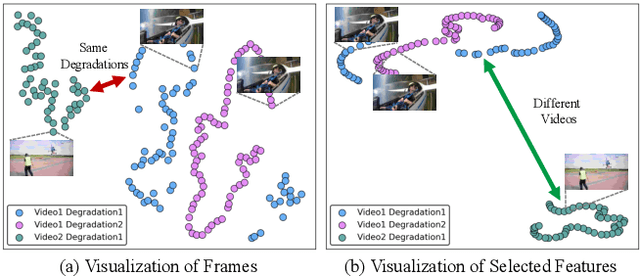
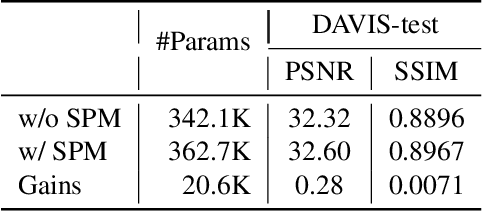
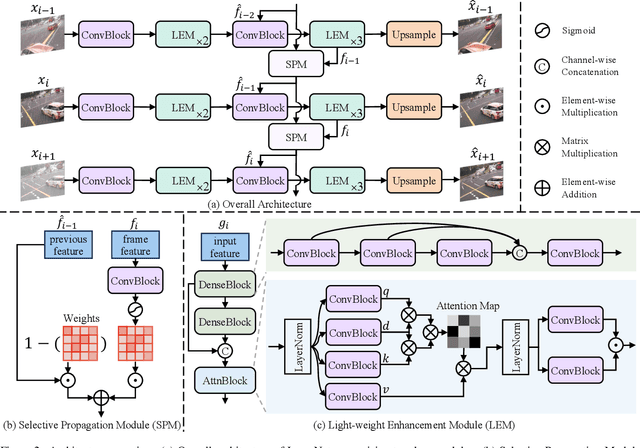
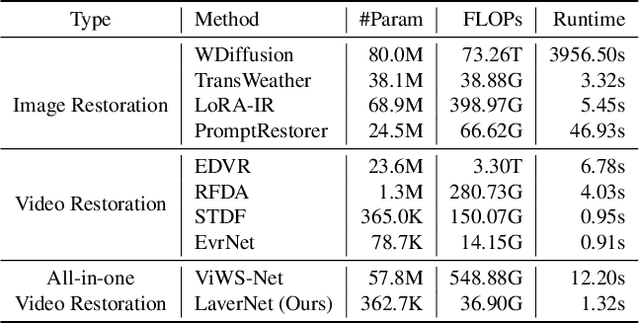
Abstract:Recent studies have explored all-in-one video restoration, which handles multiple degradations with a unified model. However, these approaches still face two challenges when dealing with time-varying degradations. First, the degradation can dominate temporal modeling, confusing the model to focus on artifacts rather than the video content. Second, current methods typically rely on large models to handle all-in-one restoration, concealing those underlying difficulties. To address these challenges, we propose a lightweight all-in-one video restoration network, LaverNet, with only 362K parameters. To mitigate the impact of degradations on temporal modeling, we introduce a novel propagation mechanism that selectively transmits only degradation-agnostic features across frames. Through LaverNet, we demonstrate that strong all-in-one restoration can be achieved with a compact network. Despite its small size, less than 1\% of the parameters of existing models, LaverNet achieves comparable, even superior performance across benchmarks.
Toward Robust and Harmonious Adaptation for Cross-modal Retrieval
Nov 18, 2025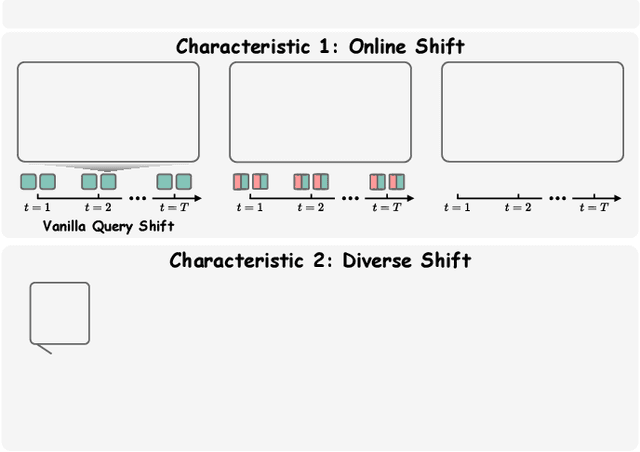
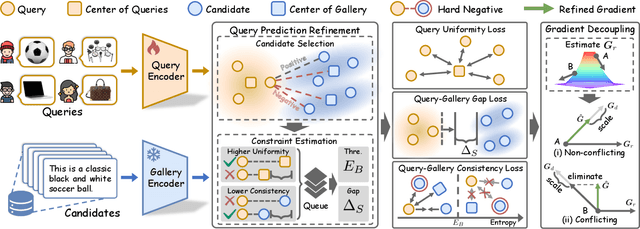


Abstract:Recently, the general-to-customized paradigm has emerged as the dominant approach for Cross-Modal Retrieval (CMR), which reconciles the distribution shift problem between the source domain and the target domain. However, existing general-to-customized CMR methods typically assume that the entire target-domain data is available, which is easily violated in real-world scenarios and thus inevitably suffer from the query shift (QS) problem. Specifically, query shift embraces the following two characteristics and thus poses new challenges to CMR. i) Online Shift: real-world queries always arrive in an online manner, rendering it impractical to access the entire query set beforehand for customization approaches; ii) Diverse Shift: even with domain customization, the CMR models struggle to satisfy queries from diverse users or scenarios, leaving an urgent need to accommodate diverse queries. In this paper, we observe that QS would not only undermine the well-structured common space inherited from the source model, but also steer the model toward forgetting the indispensable general knowledge for CMR. Inspired by the observations, we propose a novel method for achieving online and harmonious adaptation against QS, dubbed Robust adaptation with quEry ShifT (REST). To deal with online shift, REST first refines the retrieval results to formulate the query predictions and accordingly designs a QS-robust objective function on these predictions to preserve the well-established common space in an online manner. As for tackling the more challenging diverse shift, REST employs a gradient decoupling module to dexterously manipulate the gradients during the adaptation process, thus preventing the CMR model from forgetting the general knowledge. Extensive experiments on 20 benchmarks across three CMR tasks verify the effectiveness of our method against QS.
Semantic-Consistent Bidirectional Contrastive Hashing for Noisy Multi-Label Cross-Modal Retrieval
Nov 11, 2025Abstract:Cross-modal hashing (CMH) facilitates efficient retrieval across different modalities (e.g., image and text) by encoding data into compact binary representations. While recent methods have achieved remarkable performance, they often rely heavily on fully annotated datasets, which are costly and labor-intensive to obtain. In real-world scenarios, particularly in multi-label datasets, label noise is prevalent and severely degrades retrieval performance. Moreover, existing CMH approaches typically overlook the partial semantic overlaps inherent in multi-label data, limiting their robustness and generalization. To tackle these challenges, we propose a novel framework named Semantic-Consistent Bidirectional Contrastive Hashing (SCBCH). The framework comprises two complementary modules: (1) Cross-modal Semantic-Consistent Classification (CSCC), which leverages cross-modal semantic consistency to estimate sample reliability and reduce the impact of noisy labels; (2) Bidirectional Soft Contrastive Hashing (BSCH), which dynamically generates soft contrastive sample pairs based on multi-label semantic overlap, enabling adaptive contrastive learning between semantically similar and dissimilar samples across modalities. Extensive experiments on four widely-used cross-modal retrieval benchmarks validate the effectiveness and robustness of our method, consistently outperforming state-of-the-art approaches under noisy multi-label conditions.
Conditional Representation Learning for Customized Tasks
Oct 06, 2025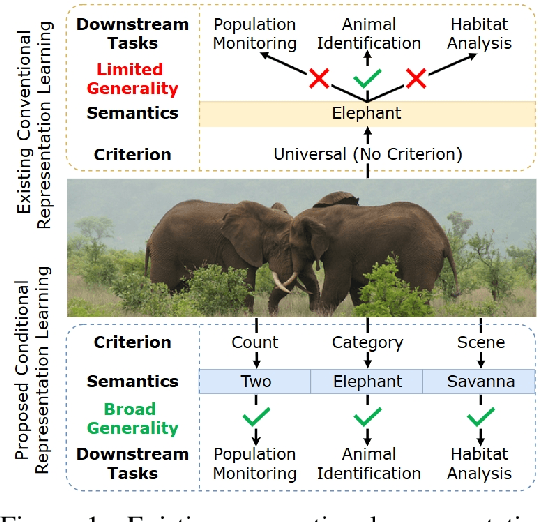



Abstract:Conventional representation learning methods learn a universal representation that primarily captures dominant semantics, which may not always align with customized downstream tasks. For instance, in animal habitat analysis, researchers prioritize scene-related features, whereas universal embeddings emphasize categorical semantics, leading to suboptimal results. As a solution, existing approaches resort to supervised fine-tuning, which however incurs high computational and annotation costs. In this paper, we propose Conditional Representation Learning (CRL), aiming to extract representations tailored to arbitrary user-specified criteria. Specifically, we reveal that the semantics of a space are determined by its basis, thereby enabling a set of descriptive words to approximate the basis for a customized feature space. Building upon this insight, given a user-specified criterion, CRL first employs a large language model (LLM) to generate descriptive texts to construct the semantic basis, then projects the image representation into this conditional feature space leveraging a vision-language model (VLM). The conditional representation better captures semantics for the specific criterion, which could be utilized for multiple customized tasks. Extensive experiments on classification and retrieval tasks demonstrate the superiority and generality of the proposed CRL. The code is available at https://github.com/XLearning-SCU/2025-NeurIPS-CRL.
DUDE: Diffusion-Based Unsupervised Cross-Domain Image Retrieval
Sep 04, 2025



Abstract:Unsupervised cross-domain image retrieval (UCIR) aims to retrieve images of the same category across diverse domains without relying on annotations. Existing UCIR methods, which align cross-domain features for the entire image, often struggle with the domain gap, as the object features critical for retrieval are frequently entangled with domain-specific styles. To address this challenge, we propose DUDE, a novel UCIR method building upon feature disentanglement. In brief, DUDE leverages a text-to-image generative model to disentangle object features from domain-specific styles, thus facilitating semantical image retrieval. To further achieve reliable alignment of the disentangled object features, DUDE aligns mutual neighbors from within domains to across domains in a progressive manner. Extensive experiments demonstrate that DUDE achieves state-of-the-art performance across three benchmark datasets over 13 domains. The code will be released.
AutoSchemaKG: Autonomous Knowledge Graph Construction through Dynamic Schema Induction from Web-Scale Corpora
May 29, 2025



Abstract:We present AutoSchemaKG, a framework for fully autonomous knowledge graph construction that eliminates the need for predefined schemas. Our system leverages large language models to simultaneously extract knowledge triples and induce comprehensive schemas directly from text, modeling both entities and events while employing conceptualization to organize instances into semantic categories. Processing over 50 million documents, we construct ATLAS (Automated Triple Linking And Schema induction), a family of knowledge graphs with 900+ million nodes and 5.9 billion edges. This approach outperforms state-of-the-art baselines on multi-hop QA tasks and enhances LLM factuality. Notably, our schema induction achieves 95\% semantic alignment with human-crafted schemas with zero manual intervention, demonstrating that billion-scale knowledge graphs with dynamically induced schemas can effectively complement parametric knowledge in large language models.
Robust Duality Learning for Unsupervised Visible-Infrared Person Re-Identfication
May 05, 2025



Abstract:Unsupervised visible-infrared person re-identification (UVI-ReID) aims to retrieve pedestrian images across different modalities without costly annotations, but faces challenges due to the modality gap and lack of supervision. Existing methods often adopt self-training with clustering-generated pseudo-labels but implicitly assume these labels are always correct. In practice, however, this assumption fails due to inevitable pseudo-label noise, which hinders model learning. To address this, we introduce a new learning paradigm that explicitly considers Pseudo-Label Noise (PLN), characterized by three key challenges: noise overfitting, error accumulation, and noisy cluster correspondence. To this end, we propose a novel Robust Duality Learning framework (RoDE) for UVI-ReID to mitigate the effects of noisy pseudo-labels. First, to combat noise overfitting, a Robust Adaptive Learning mechanism (RAL) is proposed to dynamically emphasize clean samples while down-weighting noisy ones. Second, to alleviate error accumulation-where the model reinforces its own mistakes-RoDE employs dual distinct models that are alternately trained using pseudo-labels from each other, encouraging diversity and preventing collapse. However, this dual-model strategy introduces misalignment between clusters across models and modalities, creating noisy cluster correspondence. To resolve this, we introduce Cluster Consistency Matching (CCM), which aligns clusters across models and modalities by measuring cross-cluster similarity. Extensive experiments on three benchmarks demonstrate the effectiveness of RoDE.
LLaVA-ReID: Selective Multi-image Questioner for Interactive Person Re-Identification
Apr 15, 2025



Abstract:Traditional text-based person ReID assumes that person descriptions from witnesses are complete and provided at once. However, in real-world scenarios, such descriptions are often partial or vague. To address this limitation, we introduce a new task called interactive person re-identification (Inter-ReID). Inter-ReID is a dialogue-based retrieval task that iteratively refines initial descriptions through ongoing interactions with the witnesses. To facilitate the study of this new task, we construct a dialogue dataset that incorporates multiple types of questions by decomposing fine-grained attributes of individuals. We further propose LLaVA-ReID, a question model that generates targeted questions based on visual and textual contexts to elicit additional details about the target person. Leveraging a looking-forward strategy, we prioritize the most informative questions as supervision during training. Experimental results on both Inter-ReID and text-based ReID benchmarks demonstrate that LLaVA-ReID significantly outperforms baselines.
Improving Representation Learning of Complex Critical Care Data with ICU-BERT
Feb 26, 2025



Abstract:The multivariate, asynchronous nature of real-world clinical data, such as that generated in Intensive Care Units (ICUs), challenges traditional AI-based decision-support systems. These often assume data regularity and feature independence and frequently rely on limited data scopes and manual feature engineering. The potential of generative AI technologies has not yet been fully exploited to analyze clinical data. We introduce ICU-BERT, a transformer-based model pre-trained on the MIMIC-IV database using a multi-task scheme to learn robust representations of complex ICU data with minimal preprocessing. ICU-BERT employs a multi-token input strategy, incorporating dense embeddings from a biomedical Large Language Model to learn a generalizable representation of complex and multivariate ICU data. With an initial evaluation of five tasks and four additional ICU datasets, ICU-BERT results indicate that ICU-BERT either compares to or surpasses current performance benchmarks by leveraging fine-tuning. By integrating structured and unstructured data, ICU-BERT advances the use of foundational models in medical informatics, offering an adaptable solution for clinical decision support across diverse applications.
 Add to Chrome
Add to Chrome Add to Firefox
Add to Firefox Add to Edge
Add to Edge